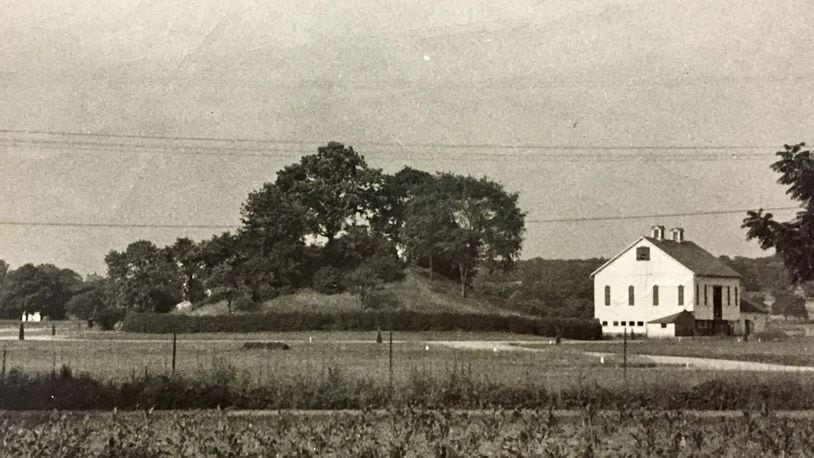It is said that George Rogers Clark used the mound in 1780 as a vantage point prior to the attack on the Shawnee village of Picawey, located less that two miles to the north. The Battle of Picawey took place soon after.
There has been no reliable report as to any professional exploration of this mound, nor have there been reliable reports on Adena artifacts or material obtained. There is a brief account of an alleged partial excavation reported in Beer’s History of Clark County. Supposedly it was opened about 1870-1880 by local young people. The indentation on the northwest side and an irregular area where dirt was thrown are very likely the result of this excavation.
It was reported by them that they went down the center from the top and found a room of stone construction. It was the shape of a bake oven and high enough to stand inside. It tapered down on the sides and it appeared to have a crawl tunnel on the west side. In the center there supposedly was a pile of dirt and stone resembling an altar on which were small animal bones, charcoal and decayed wood. The diggers said they carved their names on the altar, filled up the excavation, and left. There was no mention of artifacts or burials.
The Mound Farm was 84.64 acres and was purchased by Charles Beaver from Paul Pence in 1952. Beaver was a real estate developer and he developed Indian Mound Estates. The Mound, encompassing over one acre, was deeded to the village in 1953 and is located on Indian Drive with a circle around the mound.
The mound is 574 feet around the perimeter. It is estimated there are 12,800 cubic feet of soil and it would require 2,133 trucks to move it. The average load by Adena natives was about 35 pounds each, so it would have taken about one million person loads to carry from the surrounding area.
Enon Mound was the center of a large dirt racetrack in the early 1900s. Thoroughbred horses raced and won awards at state fairs. Evidence of the track exists on lot No. 7 on Meadow Lane.
Another reference was from History of the Church of Jesus Christ of Latter-day Saints, written by Joseph Smith in the 1830s. This history is about the Mormons’ route to Utah from Kirtland, Ohio. There were about 600 people.
“Friday, May 16th — About nine o’clock while I was riding in a wagon … we came into a piece of thick woods … In about forty rods … saw a large farm, and there near the road on our left, was a mound sixty feet high, containing human bones (this was speculation and he assumed it was bones from the dead from Battle of Picawey).”
An interesting side note, there is evidence that the Mormons trekked through what is Wright-Patterson Air Force Base and camped along Mad River near Huffman Prairie.
The mound will be celebrated with the placement of a new information sign this spring, produced by the Enon Community Historical Society.
Ann Ingoldsby is with the Enon Community Historical Society.
About the Author
